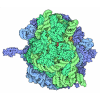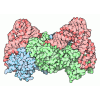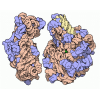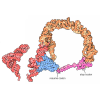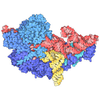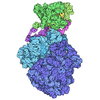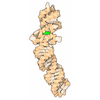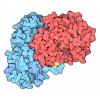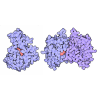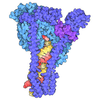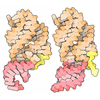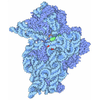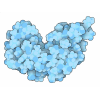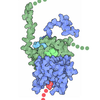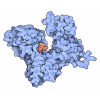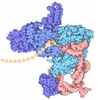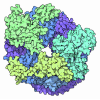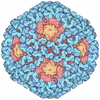[English] 日本語
 Yorodumi
Yorodumi- PDB-9c3h: Structure of the CNOT3-bound human 80S ribosome with tRNA-ARG in ... -
+ Open data
Open data
- Basic information
Basic information
| Entry | Database: PDB / ID: 9c3h | ||||||||||||||||||||||||
|---|---|---|---|---|---|---|---|---|---|---|---|---|---|---|---|---|---|---|---|---|---|---|---|---|---|
| Title | Structure of the CNOT3-bound human 80S ribosome with tRNA-ARG in the P-site. | ||||||||||||||||||||||||
 Components Components |
| ||||||||||||||||||||||||
 Keywords Keywords | RIBOSOME / mRNA degradation / CCR4-NOT complex / tRNA | ||||||||||||||||||||||||
| Function / homology |  Function and homology information Function and homology informationCCR4-NOT core complex / CCR4-NOT complex / regulation of stem cell population maintenance / nuclear-transcribed mRNA poly(A) tail shortening / trophectodermal cell differentiation / Deadenylation of mRNA / embryonic brain development / translation at presynapse / exit from mitosis / M-decay: degradation of maternal mRNAs by maternally stored factors ...CCR4-NOT core complex / CCR4-NOT complex / regulation of stem cell population maintenance / nuclear-transcribed mRNA poly(A) tail shortening / trophectodermal cell differentiation / Deadenylation of mRNA / embryonic brain development / translation at presynapse / exit from mitosis / M-decay: degradation of maternal mRNAs by maternally stored factors / response to insecticide / eukaryotic 80S initiation complex / negative regulation of protein neddylation / optic nerve development / regulation of translation involved in cellular response to UV / axial mesoderm development / negative regulation of formation of translation preinitiation complex / regulation of G1 to G0 transition / ribosomal protein import into nucleus / negative regulation of endoplasmic reticulum unfolded protein response / oxidized pyrimidine DNA binding / response to TNF agonist / positive regulation of base-excision repair / protein-DNA complex disassembly / positive regulation of respiratory burst involved in inflammatory response / positive regulation of intrinsic apoptotic signaling pathway in response to DNA damage by p53 class mediator / regulatory ncRNA-mediated gene silencing / positive regulation of intrinsic apoptotic signaling pathway in response to DNA damage / positive regulation of gastrulation / 90S preribosome assembly / retinal ganglion cell axon guidance / protein tyrosine kinase inhibitor activity / nucleolus organization / positive regulation of endodeoxyribonuclease activity / IRE1-RACK1-PP2A complex / positive regulation of Golgi to plasma membrane protein transport / TNFR1-mediated ceramide production / negative regulation of RNA splicing / negative regulation of DNA repair / GAIT complex / positive regulation of DNA damage response, signal transduction by p53 class mediator / TP53 regulates transcription of additional cell cycle genes whose exact role in the p53 pathway remain uncertain / TORC2 complex binding / alpha-beta T cell differentiation / G1 to G0 transition / supercoiled DNA binding / neural crest cell differentiation / NF-kappaB complex / cysteine-type endopeptidase activator activity involved in apoptotic process / oxidized purine DNA binding / middle ear morphogenesis / positive regulation of ubiquitin-protein transferase activity / negative regulation of intrinsic apoptotic signaling pathway in response to hydrogen peroxide / negative regulation of bicellular tight junction assembly / regulation of establishment of cell polarity / ubiquitin-like protein conjugating enzyme binding / rRNA modification in the nucleus and cytosol / negative regulation of phagocytosis / erythrocyte homeostasis / Formation of the ternary complex, and subsequently, the 43S complex / cytoplasmic side of rough endoplasmic reticulum membrane / negative regulation of ubiquitin protein ligase activity / laminin receptor activity / protein kinase A binding / homeostatic process / ion channel inhibitor activity / Ribosomal scanning and start codon recognition / pigmentation / Translation initiation complex formation / positive regulation of mitochondrial depolarization / macrophage chemotaxis / lung morphogenesis / positive regulation of T cell receptor signaling pathway / fibroblast growth factor binding / negative regulation of Wnt signaling pathway / positive regulation of natural killer cell proliferation / monocyte chemotaxis / negative regulation of translational frameshifting / TOR signaling / Protein hydroxylation / BH3 domain binding / SARS-CoV-1 modulates host translation machinery / positive regulation of activated T cell proliferation / iron-sulfur cluster binding / regulation of adenylate cyclase-activating G protein-coupled receptor signaling pathway / cellular response to ethanol / regulation of cell division / mTORC1-mediated signalling / Peptide chain elongation / Selenocysteine synthesis / positive regulation of intrinsic apoptotic signaling pathway by p53 class mediator / Formation of a pool of free 40S subunits / cellular response to actinomycin D / endonucleolytic cleavage to generate mature 3'-end of SSU-rRNA from (SSU-rRNA, 5.8S rRNA, LSU-rRNA) / Eukaryotic Translation Termination / blastocyst development / positive regulation of GTPase activity / SRP-dependent cotranslational protein targeting to membrane / negative regulation of ubiquitin-dependent protein catabolic process / Response of EIF2AK4 (GCN2) to amino acid deficiency Similarity search - Function | ||||||||||||||||||||||||
| Biological species |  Homo sapiens (human) Homo sapiens (human) | ||||||||||||||||||||||||
| Method | ELECTRON MICROSCOPY / single particle reconstruction / cryo EM / Resolution: 2 Å | ||||||||||||||||||||||||
 Authors Authors | Erzberger, J.P. / Cruz, V.E. | ||||||||||||||||||||||||
| Funding support |  United States, 7items United States, 7items
| ||||||||||||||||||||||||
 Citation Citation |  Journal: Science / Year: 2024 Journal: Science / Year: 2024Title: Specific tRNAs promote mRNA decay by recruiting the CCR4-NOT complex to translating ribosomes. Authors: Xiaoqiang Zhu / Victor Emmanuel Cruz / He Zhang / Jan P Erzberger / Joshua T Mendell /  Abstract: The CCR4-NOT complex is a major regulator of eukaryotic messenger RNA (mRNA) stability. Slow decoding during translation promotes association of CCR4-NOT with ribosomes, accelerating mRNA degradation. ...The CCR4-NOT complex is a major regulator of eukaryotic messenger RNA (mRNA) stability. Slow decoding during translation promotes association of CCR4-NOT with ribosomes, accelerating mRNA degradation. We applied selective ribosome profiling to further investigate the determinants of CCR4-NOT recruitment to ribosomes in mammalian cells. This revealed that specific arginine codons in the P-site are strong signals for ribosomal recruitment of human CNOT3, a CCR4-NOT subunit. Cryo-electron microscopy and transfer RNA (tRNA) mutagenesis demonstrated that the D-arms of select arginine tRNAs interact with CNOT3 and promote its recruitment whereas other tRNA D-arms sterically clash with CNOT3. These effects link codon content to mRNA stability. Thus, in addition to their canonical decoding function, tRNAs directly engage regulatory complexes during translation, a mechanism we term P-site tRNA-mediated mRNA decay. | ||||||||||||||||||||||||
| History |
|
- Structure visualization
Structure visualization
| Structure viewer | Molecule:  Molmil Molmil Jmol/JSmol Jmol/JSmol |
|---|
- Downloads & links
Downloads & links
- Download
Download
| PDBx/mmCIF format |  9c3h.cif.gz 9c3h.cif.gz | 5.6 MB | Display |  PDBx/mmCIF format PDBx/mmCIF format |
|---|---|---|---|---|
| PDB format |  pdb9c3h.ent.gz pdb9c3h.ent.gz | Display |  PDB format PDB format | |
| PDBx/mmJSON format |  9c3h.json.gz 9c3h.json.gz | Tree view |  PDBx/mmJSON format PDBx/mmJSON format | |
| Others |  Other downloads Other downloads |
-Validation report
| Summary document |  9c3h_validation.pdf.gz 9c3h_validation.pdf.gz | 2.1 MB | Display |  wwPDB validaton report wwPDB validaton report |
|---|---|---|---|---|
| Full document |  9c3h_full_validation.pdf.gz 9c3h_full_validation.pdf.gz | 2.3 MB | Display | |
| Data in XML |  9c3h_validation.xml.gz 9c3h_validation.xml.gz | 360.2 KB | Display | |
| Data in CIF |  9c3h_validation.cif.gz 9c3h_validation.cif.gz | 657.3 KB | Display | |
| Arichive directory |  https://data.pdbj.org/pub/pdb/validation_reports/c3/9c3h https://data.pdbj.org/pub/pdb/validation_reports/c3/9c3h ftp://data.pdbj.org/pub/pdb/validation_reports/c3/9c3h ftp://data.pdbj.org/pub/pdb/validation_reports/c3/9c3h | HTTPS FTP |
-Related structure data
| Related structure data |  45170MC  9c3iC M: map data used to model this data C: citing same article ( |
|---|---|
| Similar structure data | Similarity search - Function & homology  F&H Search F&H Search |
- Links
Links
- Assembly
Assembly
| Deposited unit | 
|
|---|---|
| 1 |
|
- Components
Components
-RNA chain , 6 types, 6 molecules L1L5L9S4S2S5
| #1: RNA chain | Mass: 50463.840 Da / Num. of mol.: 1 / Source method: isolated from a natural source / Source: (natural)  Homo sapiens (human) / References: GenBank: 555853 Homo sapiens (human) / References: GenBank: 555853 |
|---|---|
| #2: RNA chain | Mass: 1640938.625 Da / Num. of mol.: 1 / Source method: isolated from a natural source / Source: (natural)  Homo sapiens (human) Homo sapiens (human) |
| #4: RNA chain | Mass: 38998.078 Da / Num. of mol.: 1 / Source method: isolated from a natural source / Source: (natural)  Homo sapiens (human) / References: GenBank: 23898 Homo sapiens (human) / References: GenBank: 23898 |
| #6: RNA chain | Mass: 24661.789 Da / Num. of mol.: 1 / Source method: isolated from a natural source / Source: (natural)  Homo sapiens (human) Homo sapiens (human) |
| #48: RNA chain | Mass: 603582.125 Da / Num. of mol.: 1 / Source method: isolated from a natural source / Source: (natural)  Homo sapiens (human) Homo sapiens (human) |
| #49: RNA chain | Mass: 2847.742 Da / Num. of mol.: 1 / Source method: isolated from a natural source / Source: (natural)  Homo sapiens (human) Homo sapiens (human) |
+Large ribosomal subunit protein ... , 41 types, 41 molecules L8LBLCLDLELFLGLHLILJLKLMLNLOLPLQLRLSLTLULVLWLYLZLaLbLcLdLeLf...
-Protein/peptide , 1 types, 1 molecules NC
| #46: Protein/peptide | Mass: 3258.725 Da / Num. of mol.: 1 / Source method: isolated from a natural source / Source: (natural)  Homo sapiens (human) Homo sapiens (human) |
|---|
+Small ribosomal subunit protein ... , 30 types, 30 molecules S1SASCSDSESGSHSISJSKSLSMSNSOSPSQSSSTSUSVSWSXSZSaSbScSdSfSoSy
-Protein , 5 types, 5 molecules SBSYSeSgSz
| #51: Protein | Mass: 64125.828 Da / Num. of mol.: 1 / Source method: isolated from a natural source / Source: (natural)  Homo sapiens (human) / References: UniProt: O75175 Homo sapiens (human) / References: UniProt: O75175 |
|---|---|
| #72: Protein | Mass: 15366.284 Da / Num. of mol.: 1 / Source method: isolated from a natural source / Source: (natural)  Homo sapiens (human) / References: UniProt: P62847 Homo sapiens (human) / References: UniProt: P62847 |
| #78: Protein | Mass: 14415.724 Da / Num. of mol.: 1 / Source method: isolated from a natural source / Source: (natural)  Homo sapiens (human) / References: UniProt: P62861 Homo sapiens (human) / References: UniProt: P62861 |
| #80: Protein | Mass: 35115.652 Da / Num. of mol.: 1 / Source method: isolated from a natural source / Source: (natural)  Homo sapiens (human) / References: UniProt: P63244 Homo sapiens (human) / References: UniProt: P63244 |
| #83: Protein | Mass: 18004.041 Da / Num. of mol.: 1 / Source method: isolated from a natural source / Source: (natural)  Homo sapiens (human) / References: UniProt: P62979 Homo sapiens (human) / References: UniProt: P62979 |
-Non-polymers , 5 types, 9914 molecules 








| #84: Chemical | ChemComp-MG / #85: Chemical | ChemComp-K / #86: Chemical | ChemComp-B3P / | #87: Chemical | ChemComp-ZN / #88: Water | ChemComp-HOH / | |
|---|
-Details
| Has ligand of interest | N |
|---|---|
| Has protein modification | Y |
-Experimental details
-Experiment
| Experiment | Method: ELECTRON MICROSCOPY |
|---|---|
| EM experiment | Aggregation state: PARTICLE / 3D reconstruction method: single particle reconstruction |
- Sample preparation
Sample preparation
| Component | Name: 80S ribosome in complex with CNOT3 and P-site tRNA ARG CCG-1 Type: RIBOSOME / Entity ID: #1-#54, #56-#83 / Source: NATURAL |
|---|---|
| Molecular weight | Value: 4.3 MDa / Experimental value: NO |
| Source (natural) | Organism:  Homo sapiens (human) Homo sapiens (human) |
| Buffer solution | pH: 7.5 |
| Specimen | Embedding applied: NO / Shadowing applied: NO / Staining applied: NO / Vitrification applied: YES |
| Vitrification | Cryogen name: ETHANE |
- Electron microscopy imaging
Electron microscopy imaging
| Experimental equipment |  Model: Titan Krios / Image courtesy: FEI Company |
|---|---|
| Microscopy | Model: FEI TITAN KRIOS |
| Electron gun | Electron source:  FIELD EMISSION GUN / Accelerating voltage: 300 kV / Illumination mode: FLOOD BEAM FIELD EMISSION GUN / Accelerating voltage: 300 kV / Illumination mode: FLOOD BEAM |
| Electron lens | Mode: BRIGHT FIELD / Nominal defocus max: 1900 nm / Nominal defocus min: 600 nm |
| Image recording | Electron dose: 17 e/Å2 / Film or detector model: FEI FALCON IV (4k x 4k) |
- Processing
Processing
| CTF correction | Type: NONE |
|---|---|
| 3D reconstruction | Resolution: 2 Å / Resolution method: FSC 0.143 CUT-OFF / Num. of particles: 276000 / Symmetry type: POINT |
 Movie
Movie Controller
Controller


 PDBj
PDBj